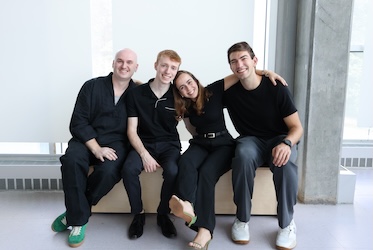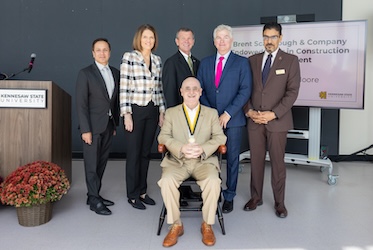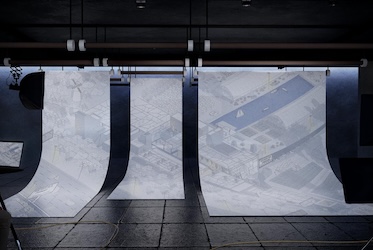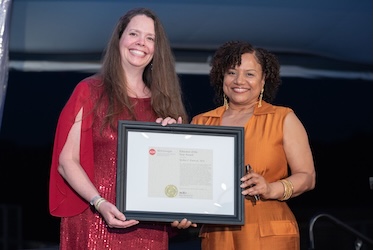

KENNESAW, Ga. | Oct 8, 2024

This semester-long endeavor reflects the students’ commitment to creating meaningful and sustainable designs. Their work focuses on connecting the historic Greenwood Bottom Black business district to downtown Macon. This concept ensures residents have easy access to housing, businesses, and amenities, which could stimulate local economic growth and enhance the quality of life for the neighborhood’s residents.
"Connecting communities through sustainable design is not just about infrastructure,” KSU Assistant Professor Robin Puttock said. “It's about creating pathways for opportunity, revitalizing history, and enriching the lives of every resident in Macon.”
The design process will take approximately four months from beginning to end, with significant progress made during the initial foundational week focused on "net zero" principles. Students from the KSU College of Architecture and Construction Management explored innovative strategies for creating buildings that generate as much energy as they consume, while also integrating "net zero water" concepts that emphasize water conservation and rainwater harvesting.
Thus far, they have developed preliminary designs that prioritize sustainability and resilience, setting a strong foundation for the project's next phases.
“By adopting net zero principles, our students are learning to design with sustainability at the forefront, making a tangible impact on the environment and the community,” Puttock said.
In the second week, the students visited Macon, immersing themselves in the project’s context. They analyzed the site and the multifamily housing program, studying various precedents from around the world. This exposure expanded their knowledge and prepared them for the conceptual phase, which started in the fourth week. Students generated and refined multiple design concepts, with plans to present these to the community for feedback on October 11.
Currently, the students are in the schematic design phase, developing several initial ideas. Community feedback will help them refine these concepts in the design development phase. This process allows them to apply integrated design principles and collaborate with mechanical engineers and commissioning agents to ensure their designs are both innovative and practical.
Puttock notes, “The iterative feedback process is crucial. It allows students to see their designs through the eyes of the community they’re aiming to serve, making their solutions more relevant and impactful.”
Incorporating the cultural elements of the Greenwood Bottom area into the design is a key focus. Students are exploring various inspirations, from the area’s musical history such as Otis Redding and James Brown, to its historic black business district and natural surroundings. This cultural integration ensures that the designs not only meet functional needs but also resonate with the local community’s identity and heritage.
“Understanding and integrating the cultural context is essential,” Puttock said. “Our students are committed to creating spaces that celebrate and preserve the rich history of Greenwood Bottom.”

“This project is a transformative experience for our students,” she said. “It bridges the gap between theoretical knowledge and practical application, showing them the real-world impact of their work.”
"This excellent project is a clear example of the type of community engagement projects CACM students and faculty frequently engage in,” Dr. Hazem Rashed-Al, Dean of the College of Architecture and Construction Management at KSU said. “These projects have direct and meaningful impacts on improving the communities they are located in."
The final designs will be presented on November 22 in Macon, showcasing the students’ ability to blend innovation with respect for the city’s historical and cultural context. The project aims to engage the community through graphic materials and presentations, fostering a deeper connection and understanding of the design process.
The experience has been both rewarding and transformative for the students. As the semester progresses, they will continue refining their designs and incorporating feedback. The final deliverables will include a comprehensive set of documents detailing their ideas, presented to the city of Macon as a token of appreciation for their collaboration.
Throughout this project, Kennesaw State University’s students are not only honing their architectural skills but also contributing to the future of a community. Emmaline Payne, an architecture student involved in the MLK Blvd project, expressed her gratitude for being able to take part in the initiative.
"Working on the MLK Blvd project has been rewarding,” Payne said. “It's inspiring to design a space that addresses community challenges while honoring its rich history. By creating a hub for local entrepreneurs and improving pedestrian access, we aim to revitalize Greenwood Bottom and foster a thriving community."
– Story by Raynard Churchwell
Photos submitted

Kennesaw State architecture students earn recognition in international design competition

Kennesaw State's Brian Moore installed as Brent Scarbrough and Company Endowed Chair in Construction Management

Kennesaw State graduates earn international recognition for award-winning architectural drawing

Kennesaw State assistant professor named 2025 AIA Georgia Educator of the Year
A leader in innovative teaching and learning, Kennesaw State University offers undergraduate, graduate, and doctoral degrees to its more than 51,000 students. Kennesaw State is a member of the University System of Georgia with 11 academic colleges. The university's vibrant campus culture, diverse population, strong global ties, and entrepreneurial spirit draw students from throughout the country and the world. Kennesaw State is a Carnegie-designated doctoral research institution (R2), placing it among an elite group of only 8 percent of U.S. colleges and universities with an R1 or R2 status. For more information, visit kennesaw.edu.